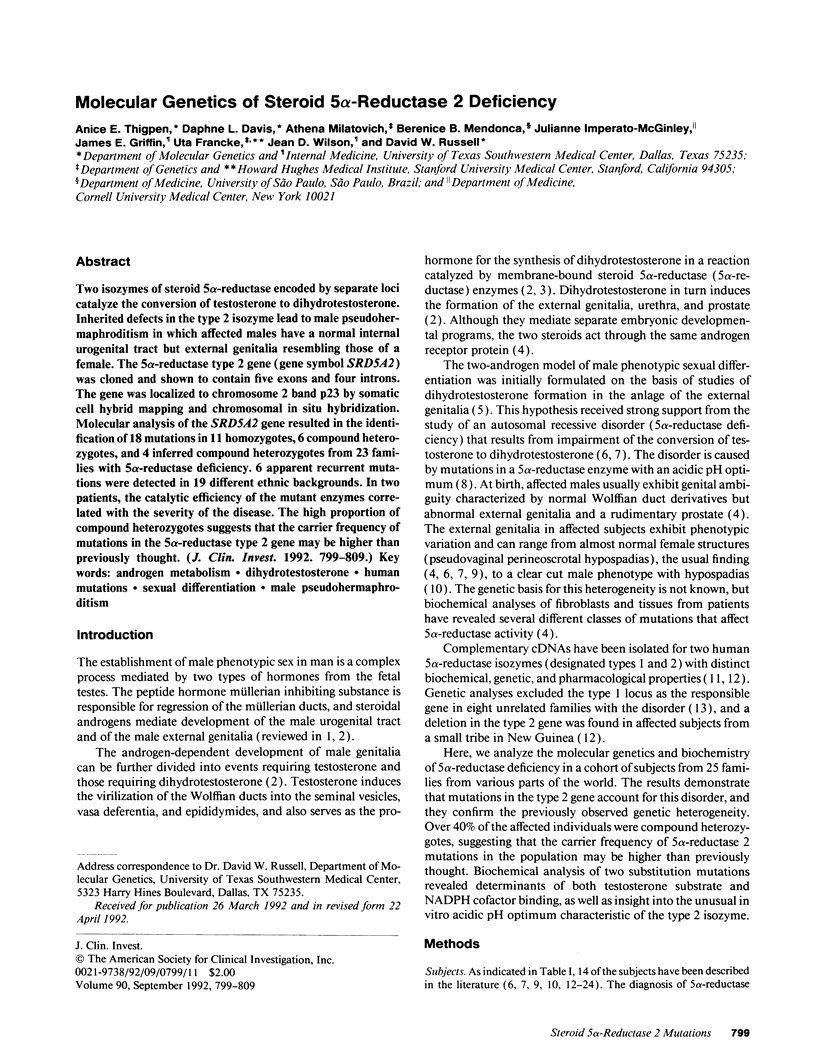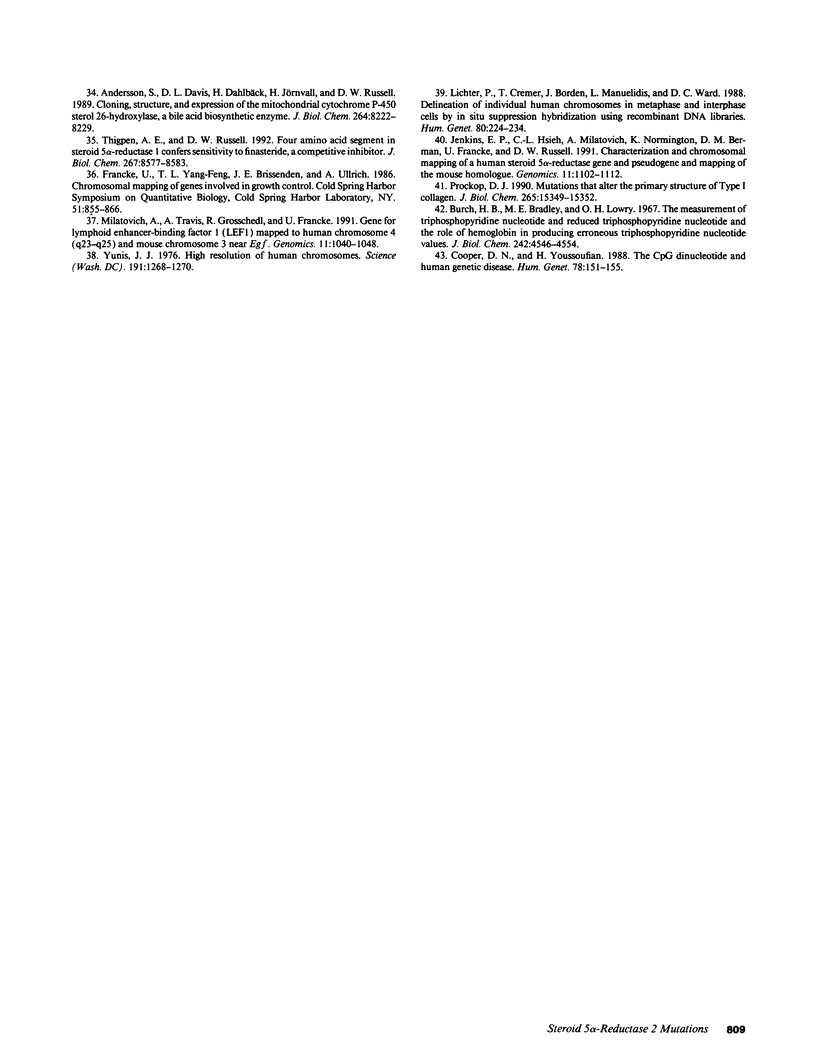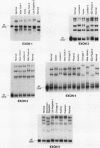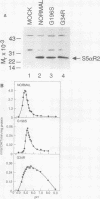Abstract
Two isozymes of steroid 5 alpha-reductase encoded by separate loci catalyze the conversion of testosterone to dihydrotestosterone. Inherited defects in the type 2 isozyme lead to male pseudohermaphroditism in which affected males have a normal internal urogenital tract but external genitalia resembling those of a female. The 5 alpha-reductase type 2 gene (gene symbol SRD5A2) was cloned and shown to contain five exons and four introns. The gene was localized to chromosome 2 band p23 by somatic cell hybrid mapping and chromosomal in situ hybridization. Molecular analysis of the SRD5A2 gene resulted in the identification of 18 mutations in 11 homozygotes, 6 compound heterozygotes, and 4 inferred compound heterozygotes from 23 families with 5 alpha-reductase deficiency. 6 apparent recurrent mutations were detected in 19 different ethnic backgrounds. In two patients, the catalytic efficiency of the mutant enzymes correlated with the severity of the disease. The high proportion of compound heterozygotes suggests that the carrier frequency of mutations in the 5 alpha-reductase type 2 gene may be higher than previously thought.
Full text
PDF










Images in this article
Selected References
These references are in PubMed. This may not be the complete list of references from this article.
- Andersson S., Berman D. M., Jenkins E. P., Russell D. W. Deletion of steroid 5 alpha-reductase 2 gene in male pseudohermaphroditism. Nature. 1991 Nov 14;354(6349):159–161. doi: 10.1038/354159a0. [DOI] [PMC free article] [PubMed] [Google Scholar]
- Andersson S., Davis D. L., Dahlbäck H., Jörnvall H., Russell D. W. Cloning, structure, and expression of the mitochondrial cytochrome P-450 sterol 26-hydroxylase, a bile acid biosynthetic enzyme. J Biol Chem. 1989 May 15;264(14):8222–8229. [PubMed] [Google Scholar]
- Andersson S., Russell D. W. Structural and biochemical properties of cloned and expressed human and rat steroid 5 alpha-reductases. Proc Natl Acad Sci U S A. 1990 May;87(10):3640–3644. doi: 10.1073/pnas.87.10.3640. [DOI] [PMC free article] [PubMed] [Google Scholar]
- Bartsch G., Decristoforo A., Schweikert U. Pseudovaginal perineoscrotal hypospadias. Clinical, endocrinological and biochemical characterization of a patient. Eur Urol. 1987;13(6):386–389. [PubMed] [Google Scholar]
- Burch H. B., Bradley M. E., Lowry O. H. The measurement of triphosphopyridine nucleotide and reduced triphosphopyridine nucleotide and the role of hemoglobin in producing erroneous triphosphopyridine nucleotide values. J Biol Chem. 1967 Oct 10;242(19):4546–4554. [PubMed] [Google Scholar]
- Carpenter T. O., Imperato-McGinley J., Boulware S. D., Weiss R. M., Shackleton C., Griffin J. E., Wilson J. D. Variable expression of 5 alpha-reductase deficiency: presentation with male phenotype in a child of Greek origin. J Clin Endocrinol Metab. 1990 Aug;71(2):318–322. doi: 10.1210/jcem-71-2-318. [DOI] [PubMed] [Google Scholar]
- Church G. M., Gilbert W. Genomic sequencing. Proc Natl Acad Sci U S A. 1984 Apr;81(7):1991–1995. doi: 10.1073/pnas.81.7.1991. [DOI] [PMC free article] [PubMed] [Google Scholar]
- Cooper D. N., Youssoufian H. The CpG dinucleotide and human genetic disease. Hum Genet. 1988 Feb;78(2):151–155. doi: 10.1007/BF00278187. [DOI] [PubMed] [Google Scholar]
- Fisher L. K., Kogut M. D., Moore R. J., Goebelsmann U., Weitzman J. J., Isaacs H., Jr, Griffin J. E., Wilson J. D. Clinical, endocrinological, and enzymatic characterization of two patients with 5 alpha-reductase deficiency: evidence that a single enzyme is responsible for the 5 alpha-reduction of cortisol and testosterone. J Clin Endocrinol Metab. 1978 Sep;47(3):653–664. doi: 10.1210/jcem-47-3-653. [DOI] [PubMed] [Google Scholar]
- Francke U., Yang-Feng T. L., Brissenden J. E., Ullrich A. Chromosomal mapping of genes involved in growth control. Cold Spring Harb Symp Quant Biol. 1986;51(Pt 2):855–866. doi: 10.1101/sqb.1986.051.01.099. [DOI] [PubMed] [Google Scholar]
- Goebelsmann U., Hall T. D., Paul W. L., Stanczyk F. Z. In vitro steroid metabolic studies in testicular 17 beta-reduction deficiency. J Clin Endocrinol Metab. 1975 Dec;41(06):1136–1143. doi: 10.1210/jcem-41-6-1136. [DOI] [PubMed] [Google Scholar]
- Imperato-McGinley J., Guerrero L., Gautier T., Peterson R. E. Steroid 5alpha-reductase deficiency in man: an inherited form of male pseudohermaphroditism. Science. 1974 Dec 27;186(4170):1213–1215. doi: 10.1126/science.186.4170.1213. [DOI] [PubMed] [Google Scholar]
- Imperato-McGinley J., Miller M., Wilson J. D., Peterson R. E., Shackleton C., Gajdusek D. C. A cluster of male pseudohermaphrodites with 5 alpha-reductase deficiency in Papua New Guinea. Clin Endocrinol (Oxf) 1991 Apr;34(4):293–298. doi: 10.1111/j.1365-2265.1991.tb03769.x. [DOI] [PubMed] [Google Scholar]
- Imperato-McGinley J., Peterson R. E., Gautier T., Sturla E. Male pseudohermaphroditism secondary to 5 alpha-reductase deficiency--a model for the role of androgens in both the development of the male phenotype and the evolution of a male gender identity. J Steroid Biochem. 1979 Jul;11(1B):637–645. doi: 10.1016/0022-4731(79)90093-1. [DOI] [PubMed] [Google Scholar]
- Imperato-McGinley J., Peterson R. E., Leshin M., Griffin J. E., Cooper G., Draghi S., Berenyi M., Wilson J. D. Steroid 5 alpha-reductase deficiency in a 65-year-old male pseudohermaphrodite: the natural history, ultrastructure of the testes, and evidence for inherited enzyme heterogeneity. J Clin Endocrinol Metab. 1980 Jan;50(1):15–22. doi: 10.1210/jcem-50-1-15. [DOI] [PubMed] [Google Scholar]
- Jenkins E. P., Andersson S., Imperato-McGinley J., Wilson J. D., Russell D. W. Genetic and pharmacological evidence for more than one human steroid 5 alpha-reductase. J Clin Invest. 1992 Jan;89(1):293–300. doi: 10.1172/JCI115574. [DOI] [PMC free article] [PubMed] [Google Scholar]
- Jenkins E. P., Hsieh C. L., Milatovich A., Normington K., Berman D. M., Francke U., Russell D. W. Characterization and chromosomal mapping of a human steroid 5 alpha-reductase gene and pseudogene and mapping of the mouse homologue. Genomics. 1991 Dec;11(4):1102–1112. doi: 10.1016/0888-7543(91)90038-g. [DOI] [PubMed] [Google Scholar]
- Johnson L., George F. W., Neaves W. B., Rosenthal I. M., Christensen R. A., Decristoforo A., Schweikert H. U., Sauer M. V., Leshin M., Griffin J. E. Characterization of the testicular abnormality in 5 alpha-reductase deficiency. J Clin Endocrinol Metab. 1986 Nov;63(5):1091–1099. doi: 10.1210/jcem-63-5-1091. [DOI] [PubMed] [Google Scholar]
- Kunkel T. A., Roberts J. D., Zakour R. A. Rapid and efficient site-specific mutagenesis without phenotypic selection. Methods Enzymol. 1987;154:367–382. doi: 10.1016/0076-6879(87)54085-x. [DOI] [PubMed] [Google Scholar]
- Lee J. S. Alternative dideoxy sequencing of double-stranded DNA by cyclic reactions using Taq polymerase. DNA Cell Biol. 1991 Jan-Feb;10(1):67–73. doi: 10.1089/dna.1991.10.67. [DOI] [PubMed] [Google Scholar]
- Leshin M., Griffin J. E., Wilson J. D. Hereditary male pseudohermaphroditism associated with an unstable form of 5 alpha-reductase. J Clin Invest. 1978 Sep;62(3):685–691. doi: 10.1172/JCI109176. [DOI] [PMC free article] [PubMed] [Google Scholar]
- Lichter P., Cremer T., Borden J., Manuelidis L., Ward D. C. Delineation of individual human chromosomes in metaphase and interphase cells by in situ suppression hybridization using recombinant DNA libraries. Hum Genet. 1988 Nov;80(3):224–234. doi: 10.1007/BF01790090. [DOI] [PubMed] [Google Scholar]
- Milatovich A., Travis A., Grosschedl R., Francke U. Gene for lymphoid enhancer-binding factor 1 (LEF1) mapped to human chromosome 4 (q23-q25) and mouse chromosome 3 near Egf. Genomics. 1991 Dec;11(4):1040–1048. doi: 10.1016/0888-7543(91)90030-i. [DOI] [PubMed] [Google Scholar]
- Moore R. J., Wilson J. D. Steroid 5alpha-reductase in cultured human fibroblasts. Biochemical and genetic evidence for two distinct enzyme activities. J Biol Chem. 1976 Oct 10;251(19):5895–5900. [PubMed] [Google Scholar]
- Orita M., Iwahana H., Kanazawa H., Hayashi K., Sekiya T. Detection of polymorphisms of human DNA by gel electrophoresis as single-strand conformation polymorphisms. Proc Natl Acad Sci U S A. 1989 Apr;86(8):2766–2770. doi: 10.1073/pnas.86.8.2766. [DOI] [PMC free article] [PubMed] [Google Scholar]
- Orita M., Suzuki Y., Sekiya T., Hayashi K. Rapid and sensitive detection of point mutations and DNA polymorphisms using the polymerase chain reaction. Genomics. 1989 Nov;5(4):874–879. doi: 10.1016/0888-7543(89)90129-8. [DOI] [PubMed] [Google Scholar]
- Peterson R. E., Imperato-McGinley J., Gautier T., Shackleton C. Urinary steroid metabolites in subjects with male pseudohermaphroditism due to 5 alpha-reductase deficiency. Clin Endocrinol (Oxf) 1985 Jul;23(1):43–53. doi: 10.1111/j.1365-2265.1985.tb00181.x. [DOI] [PubMed] [Google Scholar]
- Peterson R. E., Imperato-McGinley J., Gautier T., Sturla E. Male pseudohermaphroditism due to steroid 5-alpha-reductase deficiency. Am J Med. 1977 Feb;62(2):170–191. doi: 10.1016/0002-9343(77)90313-8. [DOI] [PubMed] [Google Scholar]
- Price P., Wass J. A., Griffin J. E., Leshin M., Savage M. O., Large D. M., Bu'Lock D. E., Anderson D. C., Wilson J. D., Besser G. M. High dose androgen therapy in male pseudohermaphroditism due to 5 alpha-reductase deficiency and disorders of the androgen receptor. J Clin Invest. 1984 Oct;74(4):1496–1508. doi: 10.1172/JCI111563. [DOI] [PMC free article] [PubMed] [Google Scholar]
- Prockop D. J. Mutations that alter the primary structure of type I collagen. The perils of a system for generating large structures by the principle of nucleated growth. J Biol Chem. 1990 Sep 15;265(26):15349–15352. [PubMed] [Google Scholar]
- Saiki R. K., Gelfand D. H., Stoffel S., Scharf S. J., Higuchi R., Horn G. T., Mullis K. B., Erlich H. A. Primer-directed enzymatic amplification of DNA with a thermostable DNA polymerase. Science. 1988 Jan 29;239(4839):487–491. doi: 10.1126/science.2448875. [DOI] [PubMed] [Google Scholar]
- Savage M. O., Preece M. A., Jeffcoate S. L., Ransley P. G., Rumsby G., Mansfield M. D., Williams D. I. Familial male pseudohermaphroditism due to deficiency of 5 alpha-reductase. Clin Endocrinol (Oxf) 1980 Apr;12(4):397–406. doi: 10.1111/j.1365-2265.1980.tb02727.x. [DOI] [PubMed] [Google Scholar]
- Thigpen A. E., Russell D. W. Four-amino acid segment in steroid 5 alpha-reductase 1 confers sensitivity to finasteride, a competitive inhibitor. J Biol Chem. 1992 Apr 25;267(12):8577–8583. [PubMed] [Google Scholar]
- Walsh P. C., Madden J. D., Harrod M. J., Goldstein J. L., MacDonald P. C., Wilson J. D. Familial incomplete male pseudohermaphroditism, type 2. Decreased dihydrotestosterone formation in pseudovaginal perineoscrotal hypospadias. N Engl J Med. 1974 Oct 31;291(18):944–949. doi: 10.1056/NEJM197410312911806. [DOI] [PubMed] [Google Scholar]
- Wilson J. D., Lasnitzki I. Dihydrotestosterone formation in fetal tissues of the rabbit and rat. Endocrinology. 1971 Sep;89(3):659–668. doi: 10.1210/endo-89-3-659. [DOI] [PubMed] [Google Scholar]
- Wilson J. D. Sexual differentiation. Annu Rev Physiol. 1978;40:279–306. doi: 10.1146/annurev.ph.40.030178.001431. [DOI] [PubMed] [Google Scholar]
- Wilson J. D. The endocrine control of sexual differentiation. Harvey Lect. 1983 1984;79:145–172. [PubMed] [Google Scholar]
- Yunis J. J. High resolution of human chromosomes. Science. 1976 Mar 26;191(4233):1268–1270. doi: 10.1126/science.1257746. [DOI] [PubMed] [Google Scholar]
- Zoller M. J., Smith M. Oligonucleotide-directed mutagenesis: a simple method using two oligonucleotide primers and a single-stranded DNA template. DNA. 1984 Dec;3(6):479–488. doi: 10.1089/dna.1.1984.3.479. [DOI] [PubMed] [Google Scholar]





